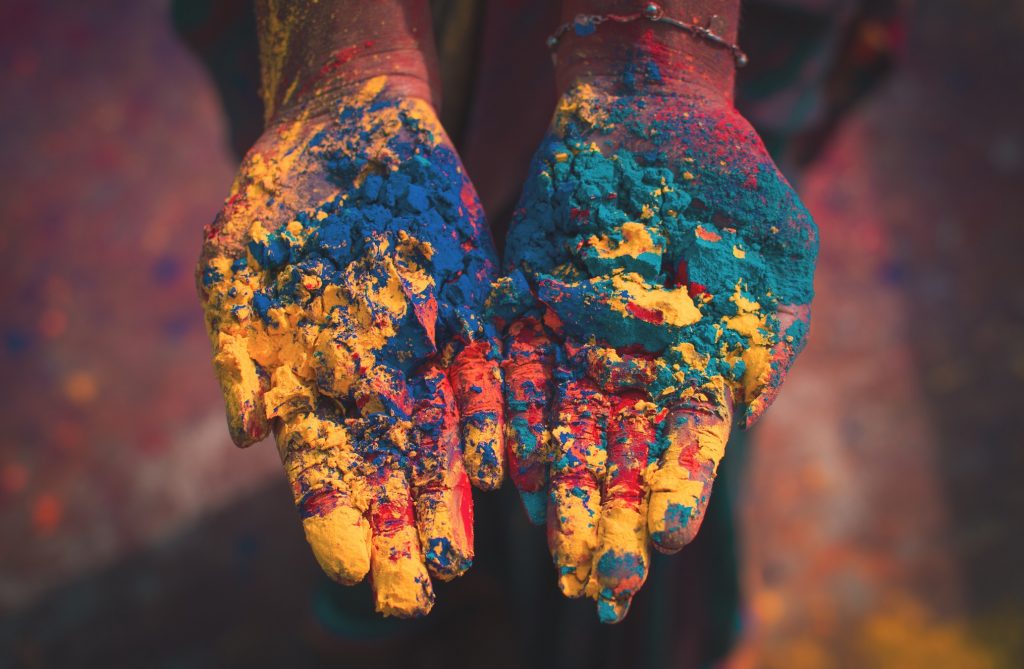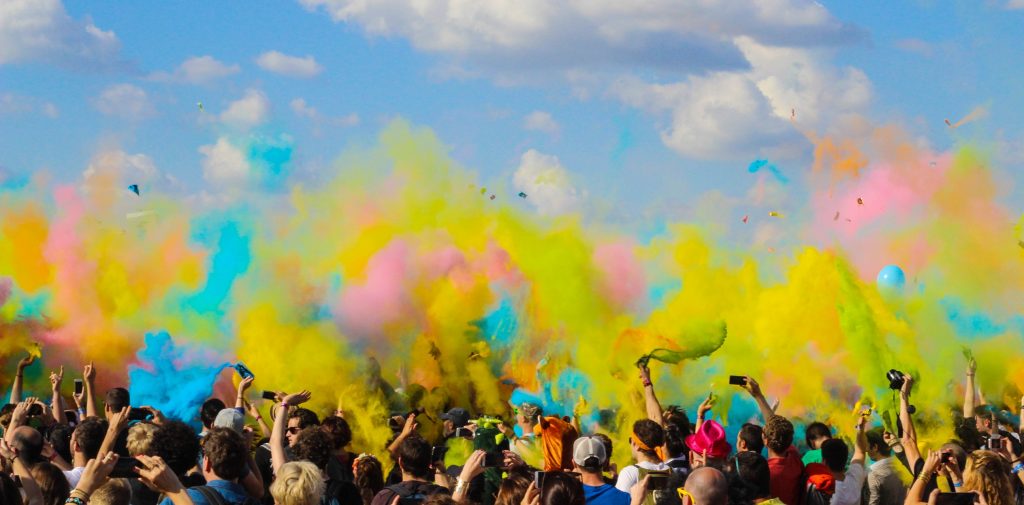
Holi is the festival of colours in India that also marks the arrival of spring – a season of joy and hope. The festival is famous for its colours and how people apply them to each other’s face. I remember one horrendous incident a few years ago that left my face scarred due to an allergic reaction and I was on anti-allergens for over a month. The culprit was a toxic paste colour that my skin came in contact with. I, therefore, thought I should share some good ways to enjoy a safe and non-toxic Holi this year.
In the last couple of years, chemical colours are being used to celebrate Holi as they are cheaper than natural colours. Chemical colours can be very harmful to the health and skin of individuals as well as the environment.
Use of safe, natural and eco-friendly colours, can help to save our environment and conserve our biodiversity. Natural colours are obtained from skin friendly sources such as turmeric, flower extracts, sandalwood powder, mehndi (Henna), etc and are safe to use.
Here’s How You Can Create Safe, Non-toxic Colours
- Brown color: Brown is one color that is never spotted anywhere in the color markets during Holi. So go ahead and surprise your visitors with this different and amazing color! Acacia catechu (Kattha) – which is commonly consumed with betel leaves (pan) gives a brownish color when mixed with water.
Other methods: Boil tea or coffee leaves in water. Cool it and use it. - Saffron: Soak a few stalks of Saffron in 2 tablespoons of water. Leave for a few hours and grind them to make a fine paste. Dilute that with water as per the desired color strength.
Other methods: The Flame of the Forest, commonly known as Tesu, Palash or Dhak, is the source of the wonderful, traditional color for Holi. For fragrant yellowish-orange colored water, the flowers are soaked overnight in water and can also be boiled. - Green: Save a trip to the parlor by using green colored henna powder (Mehendi) this Holi. Either use it separately or mix it with an equal quantity of any suitable flour to get a lovely and natural green shade. Make sure to use pure henna that does not have Amla (Indian Gooseberries) mixed in it, as this would be brown in color. Dry henna will not leave color on your face and can be easily brushed off. When mixed with water, it will leave a slight color, thereby making it a fast color.
Other methods: Dry and finely powder Gulmohur tree leaves or crush the tender leaves of the Wheat plant to obtain a natural green color for Holi. The color can also be obtained by mixing a fine paste of green leafy vegetables like spinach (Palak), Coriander (Dhaniya) or Mint (Pudina) in water. - Blue: Dry Jacaranda flowers (Neeli Gulmohar/Jungle Badam) in the shade and grind them to obtain a beautiful blue powder.
Other methods: The Blue Hibiscus, which is found in Kerala, can be dried and powdered just like the red hibiscus, or crush berries of Indigo plant and add water to it as per the desired colour strength. - Yellow: Mix two teaspoons of Turmeric powder with twice the quantity of gram flour (besan). Turmeric and gram flour have magical qualities that are very good for the skin. Ordinary wheat flour (Atta), refined wheat flour (Maida), rice flour, ground nut powder, fuller`s earth (Multani Mitti) and even talcum powder can be used as substitutes for gram flour. Other methods: Flowers like Cassia Fistula (Amaltas), Marigold (Gainda), Yellow Chrysanthemums and Black Babul yield different shades of yellow. Dry the petals of these flowers in the shade and crush them to obtain a fine powder. Mix an appropriate quantity of the powder with gram flour or its substitutes and see your festival come alive without any harmful effects of chemically-loaded colors.
- Pink: Slice or grate one beetroot and soak it in 1 liter of water for a wonderful magenta. Boil or leave overnight for a deeper shade and dilute it before use.
Other methods: Boil the peels of 10-15 pink onions in half a liter of water for a pinkish color. Remove the peels before using them to remove any unneeded smell. You can also soak pink Bauhinia variegate (Kachnar) flowers in water overnight or boil them for a bright pink color. - Red: Red Sandal Wood Powder, which has a beautiful red color, is extremely beneficial for the skin and can be used in place of Red Gulal.
Other methods: Dry red hibiscus flowers in shade, powder and add any flour to increase the bulk. For a bright orange-red, mix a pinch of lime powder with 2 spoons of turmeric powder and a few drops of water. Use the resulting paste only after diluting it with 10 litres of water. Peels of Red Pomegranate boiled in water, juice of tomatoes and carrots diluted with sufficient quantity of water to remove the stickiness also give a natural yet beautiful red color. - Black: Last but not the least, comes black. Often derived from very dangerous sources like used batteries, this color may cause a lot of trouble later. However, for a safe black color, boil dried fruits of Indian Gooseberry (Amla) in an iron vessel and leave it overnight. Dilute with water and use.
Other methods: Extract juice of black grapes and dilute with sufficient quantity of water to remove stickiness.
Tips For a Skin-Friendly Holi
- Cover up: Nothing can beat covering the maximum part of your body with full sleeved clothes and trousers. But the old remedy of using Mustard Oil, Coconut Oil, Olive Oil or Vaseline over your entire body on the morning of Holi does wonders in removing the colours easily
- No warm water: Do not use warm water for bathing/removing colours. This can lead to the fastening of colours. Instead, always opt for cold water to wash the colours off. You should also try to remove the dry colour powder with dry hands rather than using water as it spreads even more after water application.
- Stay Hydrated: Drink lots and lots of water as skin tends to get dehydrated with the use of chemicals. You can try other refreshing water-based drinks too. For instance, a virgin mint mojito, or fresh lime and buttermilk, to beat the heat out of your body!
- Hair Care: Before you use a shampoo, rinse your hair with water to allow the additional colours to wash off. It is extremely vital to condition your hair to prevent any hair damage. Make a simple hair pack by soaking a few Fenugreek (Methi) seeds in four tablespoons of curd. Apply this pack or egg yolk on your scalp and wash your hair with a good shampoo after 30 minutes. You can also apply a mixture of honey and olive oil for deep conditioning.
- Face: Do not scrub the colour off with soap. Opt for a mild cleanser and follow it up with lots of moisturizing cream. If you feel any skin irritation during the process of taking off the colours then take 2 tbsps. of calamine powder and mix it with a few drops of honey and rosewater to make a paste. Apply this on your face and once it has dried up, wash it off with water and apply a moisturizer. You can also take off the colour with a mixture of Gram Flour (besan) and Milk. If you are unable to do anything else, simply apply a generous amount of Multani-Mitti on the entire face and body to revive your skin.
- Natural body scrub: You can use a homemade scrub by mixing the following ingredients: 2 tbsp. Wheat Bran, 1 tbsp. Sandalwood Powder, 1 tbsp. Rice Flour, along with some Poppy Seeds (khus-khus), few drops of Honey and a mashed tomato. Scrub your body with this to clear off the colours and to bounce back to your fair and glowing skin. You can also rub a piece of papaya on coloured areas of the face and body to get rid of the colours. There is another good body scrub you can use to wash off colours. Mix curd, gram flour, orange peel powder along with little turmeric, a few drops of lemon and 1 tbsp. of olive oil. This will help clean your skin.
Post Holi Skincare Regime
For the next two weeks, apply a Multani Mitti face pack every alternate day to ensure that your skin remains soft and supple. Do not go for any skin treatments like waxing, threading, facials, or apply any other external medication on the skin for 2-3 days after Holi. Your skin is very sensitive after Holi. These treatments may cause an adverse reaction.

We hope these tips help you. For more, check out Healthy Reads or ask a GOQii Coach by subscribing for Personalised Health Coaching here.
#BeTheForce




Thanks for sharing superb information about Holi Festival : A Celebration to Express Warmth With Colors. This is very useful information for online blog readers. Keep it up such a wonderful posting like this.
Worth trying and emulating the advises.
Liked the most is , being better that you use to be…
Let’s start hitting the road……..
Jeg kan klart bedst lide den fra Vila ? er ved at være træt af flæser og det er på trods af at jeg har 2 Henna kjoler, men de bliver heller brugt i så høj grad længere.
It’s wonderful that you are getting ideas from this post as well as from our dialogue made here.
This is an informative article and in light of today’s time and needs. The ingredients of holi colours have changed over the last couple of years. Organic colours seems to be working so far. If one wants to play decent holi with colors, I think gulaal made from besan is also enough but yes, if you want to indulge in Holi madness where people like to dump others in marshes or paint them with silver and gold colours than any suggestion would not be worth trying.
A very informative article.